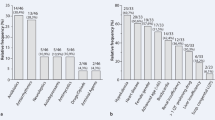Abstract
The present study aimed to investigate the causative medications and underlying risk factors that predispose to drug-induced QT interval prolongation. Twenty-one patients with drug-induced long QT (90% females, mean age 64.3 ± 14.1 years) were included in the study. Transthoracic echocardiography as well as continuous or ambulatory 48-h electrocardiographic monitoring was carried out in all patients during their hospitalization. The mean corrected QT (QTc) interval was 542 ± 56.8 ms. Known cardiac agents (mainly class III antiarrhythmics) were implicated in 13/21 (62%), antipsychotics in 8/21 (38%), and antibiotics in 5/21 patients (24%). Potential drug-interactions through inhibition of cytochrome P450 isoenzymes were considered responsible in 5/21 cases (24%). The underlying cardiovascular diseases included hypertension (57%) with left ventricular hypertrophy (29%), paroxysmal atrial tachyarrhytmias (48%), heart failure (14%), valvular heart disease (10%), and coronary artery disease (5%). Torsade de pointes (TdP) was recorded in 6/21 of patients, and cardiac arrest necessitating resuscitation occurred in five of them. A significant correlation was observed between administration of cardiac agents and TdP events (P < 0.05). TdP and cardiac arrest events were both associated with a QTc interval >510 ms (P < 0.05). Advanced age (>60 years), female gender, hypertension and paroxysmal atrial tachyarrhytmias were the most common identifiable pre-existing factors for drug-induced long QT in our patient cohort. Marked QTc interval prolongation should be considered of prognostic significance for TdP and cardiac arrest events.
Similar content being viewed by others
References
Algra A, Tijssen JG, Roelandt JR, Pool J, Lubsen J (1991) QTc prolongation measured by standard 12-lead electrocardiography is an independent risk factor for sudden death due to cardiac arrest. Circulation 83:1888–1894
Bednar MM, Harrigan EP, Ruskin JN (2002) Torsades de pointes associated with nonantiarrhythmic drugs and observations on gender and QTc. Am J Cardiol 89:1316–1319
Chatterjee B, Burgi U (2006) Syncope of a drug addict – a special case. Clin Res Cardiol 95:557–559
Drici MD, Clement N (2001) Is gender a risk factor for adverse drug reactions? The example of drug-induced long QT syndrome. Drug Saf 24:575–585
Gowda RM, Khan IA, Wilbur SL, Vasavada BC, Sacchi TJ (2004) Torsade de pointes: the clinical considerations. Int J Cardiol 96:1–6
Heist EK, Ruskin JN (2005) Drug-induced proarrhythmia and use of QTc-prolonging agents: clues for clinicians. Heart Rhythm 2:S1–S8
Kaab S, Pfeufer A, Hinterseer M, Nabauer M, Schulze-Bahr E (2004) Long QT syndrome. Why does sex matter? Z Kardiol 93:641–645
Kannankeril PJ, Roden DM (2007) Drug-induced long QT and torsade de pointes: recent advances. Curr Opin Cardiol 22:39–43
Khan IA (2002) Clinical and therapeutic aspects of congenital and acquired long QT syndrome. Am J Med 112:58–66
Lehmann MH, Hardy S, Archibald D, Quart B, MacNeil DJ (1996) Sex difference in risk of torsade de pointes with d,l-sotalol. Circulation 94:2535–2541
Letsas KP, Alexanian IP, Pappas LK, Kounas SP, Efremidis M, Sideris A, Kardaras F (2006) QT interval prolongation and torsade de pointes associated with indapamide. Int J Cardiol 112:373–374
Ohyama K, Nakajima M, Suzuki M, Shimada N, Yamazaki H, Yokoi T (2000) Inhibitory effects of amiodarone and its N-deethylated metabolite on human cytochrome P450 activities: prediction of in vivo drug interactions. Br J Clin Pharmacol 49:244–253
Pfeufer A, Jalilzadeh S, Perz S, Mueller JC, Hinterseer M, Illig T, Akyol M, Huth C, Schopfer-Wendels A, Kuch B, Steinbeck G, Holle R, Nabauer M, Wichmann HE, Meitinger T, Kaab S (2005) Common variants in myocardial ion channel genes modify the QT interval in the general population: results from the KORA study. Circ Res 96:693–701
Priori SG, Napolitano C (2002) Genetic defects of cardiac ion channels. The hidden substrate for torsades de pointes. Cardiovasc Drugs Ther 16:89–92
Priori SG, Schwartz PJ, Napolitano C, Bloise R, Ronchetti E, Grillo M, Vicentini A, Spazzolini C, Nastoli J, Bottelli G, Folli R, Cappelletti D (2003) Risk stratification in the long-QT syndrome. N Engl J Med 348:1866–1874
Roden DM (2004) Drug-induced prolongation of the QT interval. N Engl J Med 350:1013–1022
Rosati B, Rocchetti M, Zaza A, Wanke E (1998) Sulfonylureas blockade of neural and cardiac HERG channels. FEBS Lett 440:125–130.
Straus SM, Sturkenboom MC, Bleumink GS, Dieleman JP, van der Lei J, de Graeff PA, Kingma JH, Stricker BH (2005) Non-cardiac QTc-prolonging drugs and the risk of sudden cardiac death. Eur Heart J 26:2007–2012
van Opstal JM, Schoenmakers M, Verduyn SC, de Groot SH, Leunissen JD, van Der Hulst FF, Molenschot MM, Wellens HJ, Vos MA (2001) Chronic amiodarone evokes no torsade de pointes arrhythmias despite QT lengthening in an animal model of acquired long-QT syndrome. Circulation 104:2722–2727
Wang L, Wible BA, Wan X, Ficker E (2006) Cardiac glycosides as novel inhibitors of HERG channel trafficking. J Pharmacol Exp Ther PMID: 17095614
Yap YG, Camm AJ (2003) Drug induced QT prolongation and torsades de pointes. Heart 89:1363–1372
Zeltser D, Justo D, Halkin A, Prokhorov V, Heller K, Viskin S (2003) Torsade de pointes due to noncardiac drugs: most patients have easily identifiable risk factors. Medicine (Baltimore) 82:282–290
Author information
Authors and Affiliations
Corresponding author
Rights and permissions
About this article
Cite this article
Letsas, K.P., Efremidis, M., Kounas, S.P. et al. Clinical characteristics of patients with drug-induced QT interval prolongation and torsade de pointes: identification of risk factors. Clin Res Cardiol 98, 208–212 (2009). https://doi.org/10.1007/s00392-008-0741-y
Received:
Accepted:
Published:
Issue Date:
DOI: https://doi.org/10.1007/s00392-008-0741-y




